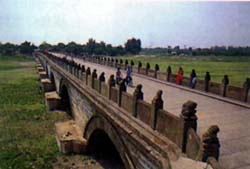|
Marco Polo Bridge

Located 16km (10 miles) southwest of Beijing, the Marco Polo Bridge is the city’s oldest surviving bridge. The bridge spans the Yongding River and it is believed that from as early as the Warring States period (475-221BC) the site of the present bridge has been a strategically important point of crossing. At the time the bridge was a simple wooden crossing, but from the Jin dynasty (beginning in 265AD) onwards, when Beijing became the capital, increased traffic warranted a more permanent structure. A solid stone structure was completed in 1192 and parts of the original bridge have weathered through the centuries. Marco Polo passed this bridge in 1290 and described it so enthusiastically in his notes that it became known in Europe as the Marco Polo Bridge.
The bridge as it stands today is 235 meters (770ft) long, 8 meters (26ft) wide and made entirely of marble. Lining the bridge are 2 rows of carved white marble balustrades topped by posts carved with figures of lions. The lions are shown in different positions and from varying angles and are placed unequally among the 280 white marble posts. Each end of the bridge is guarded by stone elephants and other animals. Imperial steles also stand at each end - one memorializes the renovation of the bridge in 1698 and the other carries an inscription by Qing emperor Qianlong. The bridge is also known for the ‘Marco Polo Bridge Incident’ of July 7, 1937, when Japan attacked and occupied Beijing forcing China’s entry into World War II.
|